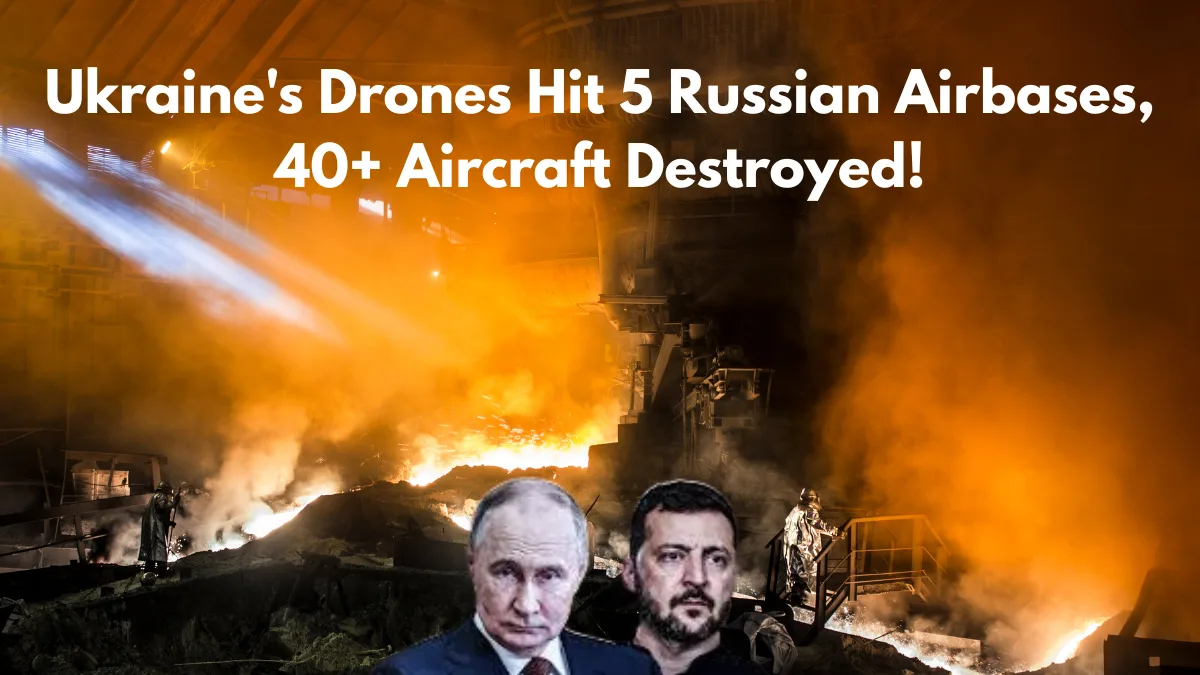n a stunning display of military strategy, Ukraine launched a massive drone attack on five Russian airbases, destroying over 40 aircraft, including strategic bombers critical to Russia’s war efforts. Codenamed “Operation Spiderweb,” this audacious strike has been hailed as a game-changer in the ongoing Russia-Ukraine conflict. Here’s everything you need to know about this unprecedented attack, its impact, and what it means for the war.
What Was Operation Spiderweb?
Ukraine’s Security Service (SBU) meticulously planned Operation Spiderweb for over 18 months, targeting Russian airbases in Murmansk, Irkutsk, Ivanovo, Ryazan, and Amur regions. According to Ukrainian officials, the operation involved smuggling 117 first-person view (FPV) drones into Russia, hidden inside trucks with retractable wooden roofs. These drones were unleashed on June 1, 2025, striking key military airfields, some as far as 4,300 kilometers from Ukraine’s border, including the Belaya airbase in Siberia.
The attack targeted high-value assets like Tu-95 and Tu-22M strategic bombers and A-50 surveillance planes, which Russia has used to launch long-range missile strikes on Ukrainian cities. Ukrainian President Volodymyr Zelenskyy personally oversaw the operation, calling it a “brilliant result” ahead of peace talks in Istanbul.
Scale of the Damage: A $7 Billion Blow to Russia
Ukraine claims the drone strikes destroyed or damaged over 40 aircraft, representing 34% of Russia’s strategic air missile carriers. The estimated financial loss to Russia is a staggering $7 billion, making this one of the most significant attacks of the war. Social media footage and satellite imagery from sources like Umbra Space confirmed the destruction, showing Tu-95 and Tu-22M3 bombers engulfed in flames at bases like Olenya in Murmansk and Belaya in Irkutsk.
Russia’s Ministry of Defense acknowledged the attacks, admitting that “several aircraft caught fire” in Murmansk and Irkutsk, though it claimed to have repelled strikes in Ivanovo, Ryazan, and Amur. Russian commentators have called it a “black day for Russian long-range aviation,” likening it to a “Pearl Harbor moment” for Moscow.
How Did Ukraine Pull Off This Attack?
The sophistication of Operation Spiderweb lies in its covert execution. Ukrainian intelligence agents smuggled FPV drones into Russia, concealing them in mobile wooden cabins mounted on trucks. At the precise moment, the roofs of these cabins were remotely opened, allowing swarms of explosive-laden drones to strike their targets. The operation’s success, even under the nose of Russia’s FSB security service, highlights Ukraine’s growing prowess in drone warfare.
Notably, the Belaya airbase in Irkutsk, over 2,500 miles from Ukraine, and the Olenya base near the Arctic Circle were among the targets. This demonstrates Ukraine’s ability to project power deep into Russian territory, a significant escalation in cross-border operations.
Why This Matters: Strategic Implications
The destruction of Tu-95, Tu-22M, and A-50 aircraft deals a severe blow to Russia’s ability to conduct long-range missile strikes on Ukraine. These planes are not only expensive but also difficult to replace, as Russia lacks the capacity to produce new strategic bombers like the Tu-95. Analysts suggest this could weaken Russia’s aerial dominance and nuclear deterrence capabilities, giving Ukraine a strategic edge.
However, the timing—on the eve of peace talks in Istanbul—raises questions. Some observers believe the attack was a bold move by Zelenskyy to strengthen Ukraine’s position at the negotiating table. Others warn that it could provoke a fierce Russian retaliation, escalating the conflict further.
Russia’s Response and the Road Ahead
Russia’s Defense Ministry labeled the strikes as “terrorist attacks” and reported no casualties, with some perpetrators allegedly detained. Meanwhile, Russia launched a massive counterattack on Ukraine the same day, deploying 472 drones and several missiles, killing 12 Ukrainian service members and injuring over 60. This led to the resignation of Ukrainian ground forces commander Mykhailo Drapatyi, who took responsibility for the losses.
As both sides prepare for peace talks, the attack underscores the fragile balance between military escalation and diplomatic efforts. While Ukraine celebrates a historic victory, the risk of Russian reprisals looms large. Will this be a turning point for Ukraine, or has it ignited a more dangerous phase of the war?
What’s Next for Ukraine and Russia?
The success of Ukraine’s drone attack highlights the growing role of drone technology in modern warfare. With FPV drones proving their effectiveness, Ukraine’s ability to strike deep inside Russia could reshape the conflict’s dynamics. For now, all eyes are on Istanbul, where peace talks may determine whether this bold move leads to a ceasefire or further escalation.
Stay Informed: Follow our updates for the latest on the Russia-Ukraine conflict, drone warfare, and global security developments. Share your thoughts in the comments—what does this attack mean for the future of the war?



